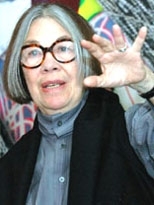Innovative design practices and recent research in urban security issues were highlighted in a series of talks presented to midcareer international students by the Department of Urban Studies and Planning.
Students in the Special Program for Urban and Regional Studies (SPURS) heard the talks, collectively titled "Myths About America," at luncheon meetings in the Stella Room, 7-338, during the fall term.
Bish Sanyal, professor of urban planning and director of SPURS, described the series as "one among many activities the program organizes for cultivating a more refined understanding of the U.S. -- this powerful and intriguing nation -- among the international fellows."
Adele Naude Santos, dean of the School of Architecture and Planning, outlined her working process and discussed challenges to building affordable housing in her talk, "From Design to Built Form," given Nov. 21.
Santos, who began practicing as an architect in her native South Africa, used dramatic photographs of single- and multi-family housing as well as slides of her own drawings to illustrate her concept of "narrative maps" as a tool in her practice.
Narrative maps are essentially the ever-refining "stories" people tell about the built spaces they want, and Santos relies on drawing by hand instead of using a computer to document the articulation and evolution of ideas.
"Drawings are an important tool for teasing out clients' ideas and vision. If you show people a computer drawing, it looks so finite, whereas drawing by hand communicates openness and passion. It articulates the process," she said.
Among Santos' passions, she said, is making apartment buildings generally, and affordable housing units in particular, "feel like houses," and she showed slides of successful projects in Japan and California that began with her literally drawing residents' sight-lines from interior to outside spaces.
An example is Santos' well-known California project, Franklin La Brea Apartments, a complex designed so that each multilevel unit offers an adult in the second-story kitchen a clear view of children in a ground-level yard.
Diane Davis, professor of political sociology and associate dean of the School of Architecture and Planning, spoke on "Policing, Security and Public Space in Latin American Cities" on Nov. 28.
Davis focused particularly on the impact of former New York City Mayor Rudy Giuliani's three-day, $4.3 million trip to Mexico City to "rescue" the downtown from crime with the "zero tolerance" policing method that had worked so well on 42nd Street and in the Bronx.
Downtown Mexico City was a "symbolic locale with both buildings of governance and tourist attractions. It was also filled with small vendors, street children and a lively informal economy. People were fearful of venturing there because of crime," Davis said.
"After 9/11, Giuliani had prestige as an 'urban security consultant,' someone who would reduce crime. But his zero tolerance recommendations -- crackdowns on squeegee men, harsh penalties for everything from drug offenses to loitering, graffiti and noise -- produced restricted movement, IT-based surveillance and circumscribed use of public space," Davis said.
According to Davis, one myth about New York-style zero tolerance policing is that it can be exported to cities outside the United States to reduce crime. In the case of Mexico City -- and Buenos Aires, Caracas and Lima -- Giuliani's strategy was used to reduce the presence of the poor in areas slated for urban renewal.
"That's redevelopment in the guise of public security," Davis said.
Other MIT speakers in the SPURS/Humphrey Program were Larry Vale, head of the Department of Urban Studies and Planning; Chancellor Philip Clay; Suzanne Berger, professor of political science and director of MISTI; and Bruce Mazlish, professor emeritus of history.
Founded in 1967 as part of MIT's Department of Urban Studies and Planning, SPURS is a one-year program designed for midcareer professionals from developing countries.
A version of this article appeared in MIT Tech Talk on December 14, 2005 (download PDF).







